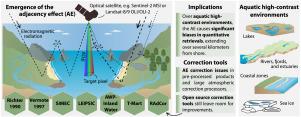光学遥感中的邻接效应:水生高对比度环境的出现、影响和校正综述。
IF 8
1区 环境科学与生态学
Q1 ENVIRONMENTAL SCIENCES
引用次数: 0
摘要
光学遥感中的邻接效应(AE)是由于周围区域反射的光子在大气中的散射进入传感器的瞬时视场(IFOV)而产生的。这导致高对比度的非均匀表面上的光谱混合,在水平距离上扩展数公里,并扭曲目标信号。因此,声发射在高对比度环境下的表面反射率定量反演和进一步的衍生信息(如基于像元的叶绿素-a浓度)中会造成显著误差。这篇综述旨在使光学遥感中声发射的小众话题更容易被更广泛的受众所了解。它为非专业人士提供了对AE的出现、影响和适用于水生高对比度环境的校正方法的理解。我们总结了该领域的关键进展,重点介绍了引入校正方法的研究。我们将引导读者了解这些研究在理论和实践中是如何工作的,并强调它们的优点和缺点。在高度动态的研究领域,近年来发表了一些很有前途的声发射校正算法。RAdCor和T-Mart以其有希望的结果和自由获取的性质脱颖而出。我们将这两种方法应用于慕尼黑(德国)南部Osterseen湖区的案例研究,展示了它们在近红外(NIR)声发射校正方面的应用和有效性,同时确定了可见光(VIS)的改进空间。这些发现也反映了本综述更广泛的结论。虽然目前的算法主要集中在操作适用性上,但未来的研究可以集中在将声发射校正扩展到非植被表面和中纬度以外的地区。本文章由计算机程序翻译,如有差异,请以英文原文为准。

The adjacency effect in optical remote sensing: A review on emergence, implications, and corrections for aquatic high-contrast environments
The adjacency effect (AE) in optical remote sensing emerges from atmospheric scattering of photons reflected from surrounding areas into the sensor’s instantaneous field of view (IFOV). This leads to spectral blending over heterogeneous surfaces with high contrast, expanding over horizontal distances of several kilometers and distorting the target signal. Therefore, AE can cause significant errors in quantitative retrieval of surface reflectance in high-contrast environments and further derived information, such as pixel-based chlorophyll-a concentration. This review aims to make the niche topic of AE in optical remote sensing more accessible to a broader audience. It provides non-specialists with an understanding of AE emergence, implications, and correction methods suitable for aquatic high-contrast environments. We summarized key advancements in the field, highlighting studies that introduced correction methods. We guide readers on how these studies theoretically and practically work, emphasizing their strengths and weaknesses. In the highly dynamic research field, some promising AE correction algorithms have been published recently. RAdCor and T-Mart stand out with their promising results and freely accessible nature. We applied both methods to a case study of the Osterseen Lake District south of Munich (Germany), demonstrating their application and effectiveness in correcting AE in the near-infrared (NIR) while identifying room for improvement in the visible light (VIS). These findings also reflect the broader conclusions of this review. While recent algorithms mainly concentrate on operational applicability, future research could focus on expanding AE correction to non-vegetated surfaces and regions beyond mid-latitudes.
求助全文
通过发布文献求助,成功后即可免费获取论文全文。
去求助
来源期刊

Science of the Total Environment
环境科学-环境科学
CiteScore
17.60
自引率
10.20%
发文量
8726
审稿时长
2.4 months
期刊介绍:
The Science of the Total Environment is an international journal dedicated to scientific research on the environment and its interaction with humanity. It covers a wide range of disciplines and seeks to publish innovative, hypothesis-driven, and impactful research that explores the entire environment, including the atmosphere, lithosphere, hydrosphere, biosphere, and anthroposphere.
The journal's updated Aims & Scope emphasizes the importance of interdisciplinary environmental research with broad impact. Priority is given to studies that advance fundamental understanding and explore the interconnectedness of multiple environmental spheres. Field studies are preferred, while laboratory experiments must demonstrate significant methodological advancements or mechanistic insights with direct relevance to the environment.
 求助内容:
求助内容: 应助结果提醒方式:
应助结果提醒方式:


